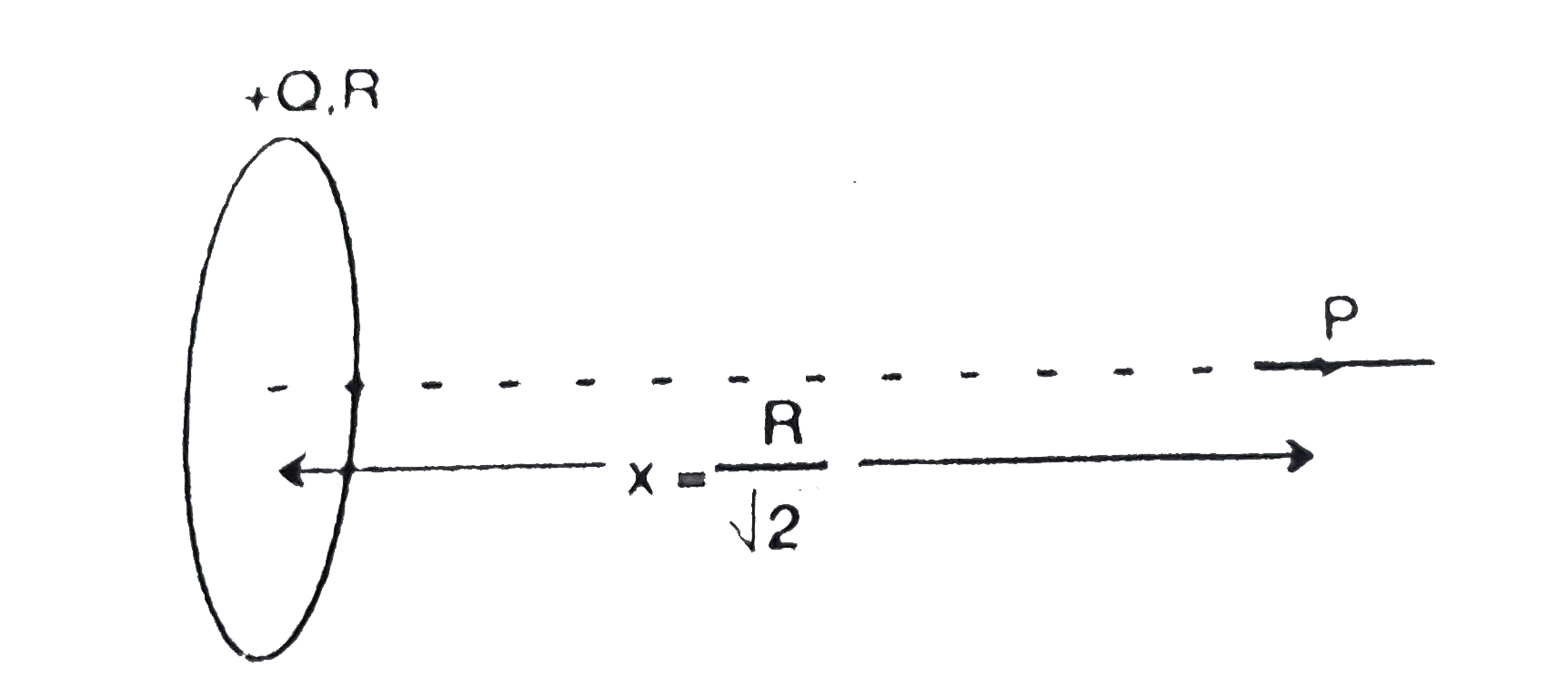The electrostatic potential of a uniformly charged thin spherical shell of charge Q and radius R at a distance r from the centre
Q4πε0r for points outside and Q4πε0R for points inside the shell
Q4πε0e for both points inside nad outside the shell
zero for points outside and Q4πε0r for points inside the shell
zero for both points inside and outside the shell
The correct Answer is:A
To find the electrostatic potential V of a uniformly charged thin spherical shell of charge Q and radius R at a distance r from the center, we can analyze two cases: when the point is inside the shell and when it is outside the shell.
Step 1: Understand the Concept of Electrostatic Potential
Electrostatic potential V at a point in space due to a charge distribution is defined as the work done in bringing a unit positive charge from infinity to that point.
Step 2: Analyze the Case for Points Inside the Shell (r<R)
For a uniformly charged thin spherical shell, the electric field inside the shell is zero. This can be derived from Gauss's law, which states that the electric field inside a uniformly charged shell is zero because the contributions from all parts of the shell cancel out.
Since the electric field E=0 inside the shell, the potential V remains constant throughout the interior of the shell. The potential inside the shell is equal to the potential at the surface of the shell.
Step 3: Calculate the Potential at the Surface of the Shell
The potential at the surface of the shell (at distance R) can be calculated using the formula for the potential due to a point charge:
V(R)=kQR
where k is Coulomb's constant.
Step 4: Conclude for Points Inside the Shell
Thus, for any point inside the shell (r<R):
V=kQR
Step 5: Analyze the Case for Points Outside the Shell (r≥R)
For points outside the shell, the shell behaves like a point charge located at its center. Therefore, we can use the same formula for the potential due to a point charge:
V(r)=kQr
where r is the distance from the center of the shell.
Step 6: Conclude for Points Outside the Shell
Thus, for any point outside the shell (r≥R):
V=kQr
Final Summary
- For r<R (inside the shell):
V=kQR
- For r≥R (outside the shell):
V=kQr
Electrostatic potential V at a point in space due to a charge distribution is defined as the work done in bringing a unit positive charge from infinity to that point.
For a uniformly charged thin spherical shell, the electric field inside the shell is zero. This can be derived from Gauss's law, which states that the electric field inside a uniformly charged shell is zero because the contributions from all parts of the shell cancel out.
The potential at the surface of the shell (at distance R) can be calculated using the formula for the potential due to a point charge:
V(R)=kQR
where k is Coulomb's constant.
Thus, for any point inside the shell (r<R):
V=kQR
For points outside the shell, the shell behaves like a point charge located at its center. Therefore, we can use the same formula for the potential due to a point charge:
V(r)=kQr
where r is the distance from the center of the shell.
Thus, for any point outside the shell (r≥R):
V=kQr
- For r<R (inside the shell):
V=kQR
- For r≥R (outside the shell):
V=kQr
Topper's Solved these Questions
- BOOK - DC PANDEY ENGLISHCHAPTER - ELECTROSTATIC POTENTIAL AND CAPACITORSEXERCISE - Check point 2.315videos
ELECTROSTATIC POTENTIAL AND CAPACITORS
- BOOK - DC PANDEY ENGLISHCHAPTER - ELECTROSTATIC POTENTIAL AND CAPACITORSEXERCISE - Check point 2.415videos
ELECTROSTATIC POTENTIAL AND CAPACITORS
- BOOK - DC PANDEY ENGLISHCHAPTER - ELECTROSTATIC POTENTIAL AND CAPACITORSEXERCISE - Check point 2.115videos
ELECTROSTATIC POTENTIAL AND CAPACITORS
- BOOK - DC PANDEY ENGLISHCHAPTER - ELECTROMAGNETIC WAVESEXERCISE - Sec C22videos
ELECTROMAGNETIC WAVES
- BOOK - DC PANDEY ENGLISHCHAPTER - ELECTROSTATICSEXERCISE - Medical entrances gallery37videos
ELECTROSTATICS
Similar Questions
Find out energy stored in the electric field of uniformly charged thin spherical shell of total charge Q and radius R.
View SolutionThe electrostatic potential inside a charged spherical ball is given by ϕ=ar2+b where r is the distance from the centre and a, b are constants. Then the charge density inside the ball is:
View SolutionA short dipole is placed on the axis of a uniformly charged ring (total charge -Q, radius R) at a distance R√2 from centre of ring as shown in figure. Find the Force on the dipole due to that ring
 View Solution
View SolutionFlux (ph) as a function of distance (r) from centre of uniformly charged solid sphere of charge Q and radius R, is best represented by
View SolutionIf the potential at the centre of a uniformly charged hollow sphere of radius R is V, then electric field at a distance r from the centre of sphere will be (r>R).
 View Solution
View SolutionFind the gravitational potential due to a spherical shell of mass M and radius R at r<R and r>R, where r is the distance from the centre of the shell.
View SolutionA point charge Q is placed inside a conducting spherical shell of inner radius 3R and outer radius 5R at a distance R from the centre of the shell. The electric potential at the centre of the shell will be
View SolutionThe electric field at a distance 3R/2 from the centre of a charge conducting spherical shell of radius R is E. The electric field at a distance R/2 from the centre of the sphere is
View SolutionThe electric field at a distance 3R/2 from the centre of a charge conducting spherical shell of radius R is E. The electric field at a distance R/2 from the centre of the sphere is
View SolutionA point charge q is placed inside a conducting spherical shell of inner radius 2R and outer radius 3R at a distance of R fro the centre of the shell. The electric potential at the centre of shell will (potential at infinity is zero).
View Solution

